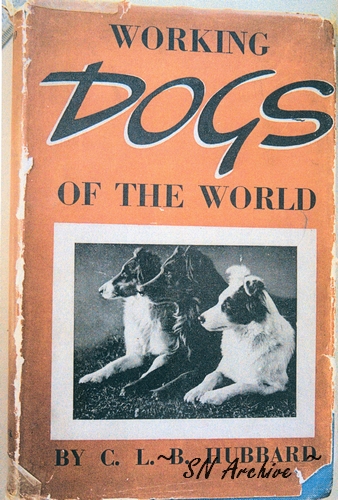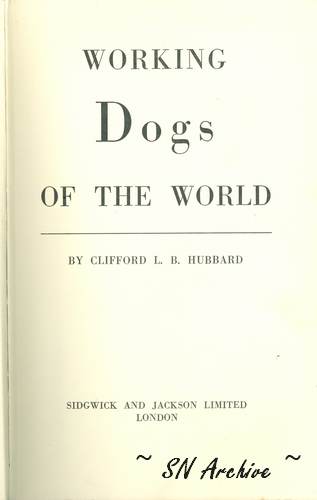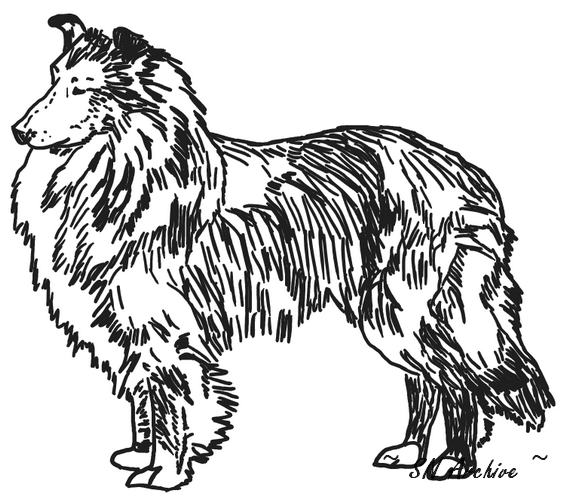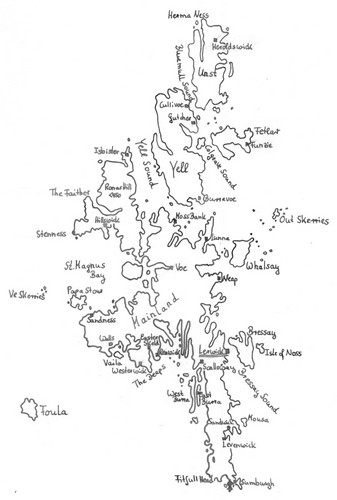  |
Working Dogs Of The World Clifford L.B. Hubbard, Sidgwick And Jackson Limited, London, 1947 1st (GB) |
A very interesting work that Doggie Hubbard dedicates to working dog breeds.
Page 1 - 3: "Part One
INTRODUCTORY
...
HISTORY
... The first book to deal almost exclusively with dogs to be published in Britain was the quaint Boke of St. Albans, actually a treatise on hunting, written by Dame Juliana Bernes (also called Barnes or Bernes), believed to have been the Prioress of a convent (Sopwell Nunnery, Herts., or St. Albans) yet an inveterate hunter and sportswoman. This treatise was printed by a St. Albans schoolmaster (a friend of the authoress) in 1486, and the reception was such that it ran to several impressions. One expects to find in the work much reference to the sporting dogs and none to the pastoral breeds. In her list of races she wrote: 'Fyrste there is a Grehoun, a Bastard, a Mengrell, a Mastiff, a Lemor, a Spanyel, Raches, Kenettys, Teroures, Butcher's Houndes, Myddyng dogges, Tryndeltaylles and Prikerid currys, and smalle ladyes' poppees that bere awaye the flees.' Now whether Sheepdogs or any other working breeds of the time appear in this list is not certain, but her 'Tryndeltaylle' was in all probability the common shepherd's dog of the period. In 1605 Shakespeare (King Lear, Act III, Scene VI, line 71) 'modernises' her list a little: 'Mastiff, greyhound, mongrel grim, Hound or spaniel, brach or lym; Or bobtail tike or trundle-tail....' Thus the 'Tryndeltaylle' was most likely the progenitor of the Working Collie, the Welsh Sheepdog or even the Shetland Sheepdog.' ...
Page 21 - 23: "THE DOGS
...
The advantages of being able to control livestock with a skill inherited from centuries of working ancestors and kept up to scratch by constant practice and effort, and at the same time being exhibited at the Dog Shows as a typical member of its race when time and opportunity present themselves with convenience are obvious ... but this happy balance of work and play has never yet come about in any one of the many working breeds. ... Consequently we find that the Collie breed generally has almost ceased to be a working breed and has become one which has sacrificed its age-old heritage for the doubtful limelight of the exhibition bench - its popularity even as a pet is waning. The same story can be told of the Old English Sheepdog of 'Bobtail', and the Shetland Sheepdog to a lesser extent. It appears that as long as a working race is in the hands of farmers and shepherds it remains a working race, but the moment it is adopted by the general populace as a pet, or by the dog tailors generally as a 'new' Fancy, and given a Club, lots publicity, and fanciful stories concerning its origin (which invariably goes back 'to the dephts of antiquity'), and some titivation in design ... then it begins to deteriorate into a pretty but useless pet. It seems it will always be so; ..."
Page 46 - 48: "Part Two
PASTORAL DOGS
...
FARM AND pastoral breeds of dogs show very considerable variation in type. It is only be expected really, for herding and droving dogs are found the world over, irrespective of whether a country be flat or mountainous, torrid or Arctic, dry or wet. Consequently we find that dogs doing precisely the same work in different parts of the world will be of vastly different type from one another, due to these differences of terrain in which they work, the kind of sheep or cattle which they control, and the special requirements of the conditions peculiar to the areas where they live. ...
In size the Sheepdogs vary greatly. The Shetland Sheepdog may be as little as 12 inches in shoulder height, ..."
Page 135 - 137: "43
THE SHETLAND SHEEPDOG
IN THE type of country where the cattle and sheep are dwarfed it is not surprising to find that the local Sheepdog is one in proportion to the size its charges: as the celebrated Shetland pony ... so also the Shetland Sheepdog. The breed is known as the Tounie Dog or Peerie Dog throughout the Outer Hebrides, the Orkneys, and to the west as far as St. Kildas, and is a splendid example of what miracles the dogtailors can perform, for in the last thirty-five years they have transformed a colony of little dogs which were heterogeneously bred into an established fancy of increasingly popular thorougbreds.
Exactly when the first dogs were taken to the isles from the Scottish mainland is not known, but more likely than not small dogs were introduced by the crofters around the beginning of the last century. Naturally the hardy shepherds of the Hebrides could not use the too large dogs of the mainland as there were frighten the small silky-coated sheep, whilst the rather heavy dogs would find the slippery shore boulders and rocks severe handicaps in their work. Again, in a place where food was not exactly plentiful at any time of the year a type of dog was preferred that in winter months could subsist on a ration of biscuits, bannock and gruel (augmented with, no doubt, helpings of the seaweed that was much the diet of the sheep, and which through its iodine content was mostly responsible for their beautiful soft coats). Moreover, the shepherds wanted small dogs that would not take up too much room in their little crofts. The name Tounie (or Toonie), taken after a collection of shepherds' crofts, and the additional name Peerie, which in the Zetland dialect means 'small' or 'miniature' were given to the newly made breed.
Although bred rather heterogeneously at first the shepherd's dog of the Shetland Isles was always kept within certain limits; it had to be small and nimble, and avove all required to work well; these desiderata outweighted any desire towards uniformity of type, coat and colour, and all the other familiar requirements in the making of the breed. However, about the beginning of the present century some deep-sea fishermen landing their catches at Lerwick began to bring back puppies, given them by the Shetlanders, to their relatives and friends in Scotland and East Anglia. These dogs were crossed with small Collies in an effort to stabilize the race, and so successful were the early attempts at improving them through a Collie outcross that in a relatively short space of time the Peerie Dog became more generally known as the Shetland Collie. As these dogs obviously became more and more like a miniature Collie and correspondingly less the mongrelized earlier edition, the efforts of the Shetland breeders towards recognition of their newly improved race grew in strength and their voice more adamant.
By the year 1908 the Shetland Collie had such a powerful clan behind it that, largely through the pioneering of Mr. Loggie, the first specialist body was formed. This was known as the Shetland Collie Club, and was founded in Lerwick in that year. However, the Collie community protested against the name Collie being incorporated in the breed title; this despite that the leading dogs of the Shetland Collies (Sheepdogs) were in reality dwarf Collies and hardly anything else but Collies. A few years before the first breed Club was formed Shetland dogs were being exhibited, and of these the most distinguished were actually half Collie; the famous 'Lerwick Jarl' (Mr. Loggie's then best dog) had Collie blood, and the first dog to achieve Championship status (Champion "Woodvold", in 1916) was the son of a Collie bitch. However, the Collie Fancy insisted upon the name Shetland Sheepdog for the breed (instead of the then title Shetland Collie) to such an extent that in 1909, when the English Kennel Club gave the breed official recognition, it was recognized as the Shetland Sheepdog, and will remain such probably for ever. One thing emerged from the quarrel, which was almost international affair, however, and that was that the publicity which attended it gave the new race such an impetus that it stil exists to-day, whereas, had there not have been the clash over its nomenclature, it would probably be unknown outside the Shetland Isles.
Champion "Riverhill Rufus", a very well-knit Shetland Sheepdog. Photo: Fall.
The Shetland Sheepdog is well established in Britain to-day and is gradually becoming better known in the U.S.A. and Canada. It is a sprightly lad with much intelligence and affection, well recommended to anyone wanting a dog which is not a Toy breed yet small enough for the modern flat. The height was once set at a maximum of 12 inches at the shoulders, but later this was made the ideal height, whilst more recently the ideal has been raised to 13 1/2 inches and the old 12 inches maximum is now about the minimum; dogs may be permitted to stand 15 inches to-day, but if over this height some coarseness is very often apparent and, moreover, it is then difficult to keep the weight down to the ideal 14 pounds.
DESCRIPTION. The Shetland Sheepdog is almost a miniature of the perfect Collie, and on broad lines a Collie description would fit the smaller breed with the obvious exception of height and weight. However, there exists a small number of subtle variations from the ideal Collie description: the skull is very often a little narrower that in the Collie; the body is generally a little more compact with a shorter back, though this is not often apparent; the feet are oval in shape as in the Collie but, whilst hare feet are considered to be faulty in the Collie, they are by no means faults in a Shetland Sheepdog; there are other very slight differences in expression and temperament. These rather subtle distinguishing characteristics are not usually recognized by the public generally, but nevertheless constitute ingredients in the distinctive character of the breed. For a broad general outline of the build, coat and colour, see Collie, p. 69."
If you discover any errors in the text that may have been caused by the transcription, please let us know for a prompt correction.

